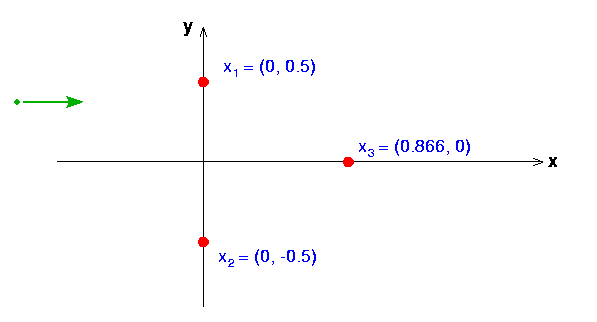Next: Chaos Manifestations Up: chaotic_scattering_story Previous: chaotic_scattering_story
We will study the scattering in two dimensions
of a mass ![]() on three repellor potential mounds.
on three repellor potential mounds.
The three force centers are located at (static)
positions
![]() .
For definiteness, take the three repellors to be identical and
lying on the vertices of an equilateral triangle:
.
For definiteness, take the three repellors to be identical and
lying on the vertices of an equilateral triangle:
![]() ,
,
![]() .
.

Each of these potential repellors is
The C code potential.c calls the function total energy() to calculate the total energy of the particle (for the parameters as in Exercise 1 below). It yields the potential energy if the velocity of the particle is zero. You can use gnuplot (sub command splot) to visualize the potential repellors. The function total_energy() in this code could be included in your numerical scattering problem solution in response to the exercises below. Here is the resulting picture:

The total acceleration
![]() is given
by a contribution from each repellor. Using
is given
by a contribution from each repellor. Using ![]() ,
,

Solving the 4 dimensional system of ODEs that results will yield the trajectory of the particle among the potential repellors.
Numerical Solution of the Scattering Model
The Runge-Kutta 4th order can be used to solve Newton's equation. Note that the equations are describing motion in 2 dimensions, i.e., Newton's equation leads to a 4 dimensional system to solve.
Use a time step
![]() , where
, where ![]() is a
parameter which may be adjusted to control the overall accuracy of the
calculation. This step should depend on
is a
parameter which may be adjusted to control the overall accuracy of the
calculation. This step should depend on ![]() as well, as in
as well, as in
![]() .
.
Rather than focusing on individual trajectories, we will instead look
at a scattering problem--that is, we imagine probing the
potential near the origin by firing a beam of particles of known
energy into it, and noting how their properties are changed when they
finally leave the interaction region. Let's choose our beam to start
at the left-hand side of the figure, at ![]() , moving to the right
with some speed
, moving to the right
with some speed ![]() , which we will hold fixed for the duration of
the experiment. Thus, the initial condition for an individual
scattering trajectory is
, which we will hold fixed for the duration of
the experiment. Thus, the initial condition for an individual
scattering trajectory is
Since the particle always has positive energy, we expect it to eventually
escape. For
![]() , the particle can never
penetrate any of the
potentials--it always ``bounces off.''
, the particle can never
penetrate any of the
potentials--it always ``bounces off.''
Note that we only need consider ![]() , by symmetry.
, by symmetry.
Michel Vallieres 2011-02-02